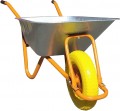Wheel type
— Monolithic (cast). As the name implies, these wheels are equipped with solid tyres (usually made of rubber) that have no voids and do not require air pumping. They are as easy to maintain as possible. there is no need to monitor the condition of the wheel and periodically pump it up. On the other hand, solid tyres “work out” shocks and shocks worse than inflatable ones, and put a greater load on the wheel rim, which increases the risk of breakage. As a result, and for some other reasons, this option is mainly used for small wheels installed in bogies (see "Type"); wheelbarrows with solid wheels are very rare and usually have a low carrying capacity (see below).
— Inflatable. Wheels, similar in design to automobiles, bicycles, etc.: they are hollow, and the necessary rigidity is provided by pumping air inside. An inflatable structure is more complicated and more expensive than a monolithic one, and it also requires regular checks and, if necessary, pumping; however, it is more resistant to high loads and is better suited for creating wheels with a large diameter and good flotation. As a result, most wheelbarrows (see "Type") are equipped with inflatable wheels; they are also found among carts, although quite rarely.
Weight
Total weight of an empty wheelbarrow/cart in standard working configuration (if equipped with detachable support legs — with legs installed, see above). This parameter allows you to estimate how much excess weight you will have to carry with you in addition to the actual cargo. However it doesn't always make sense to chase light weight — it can mean less strength.

